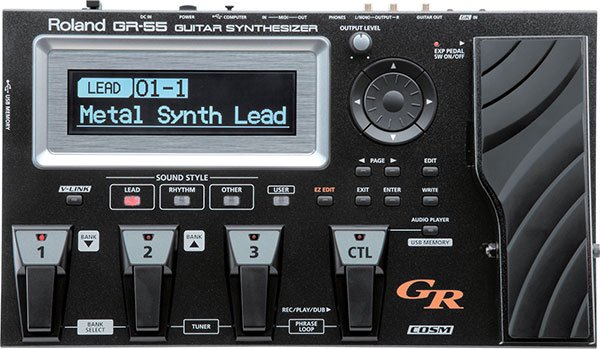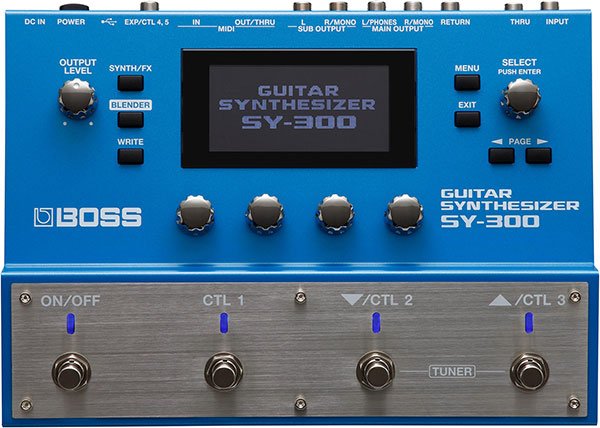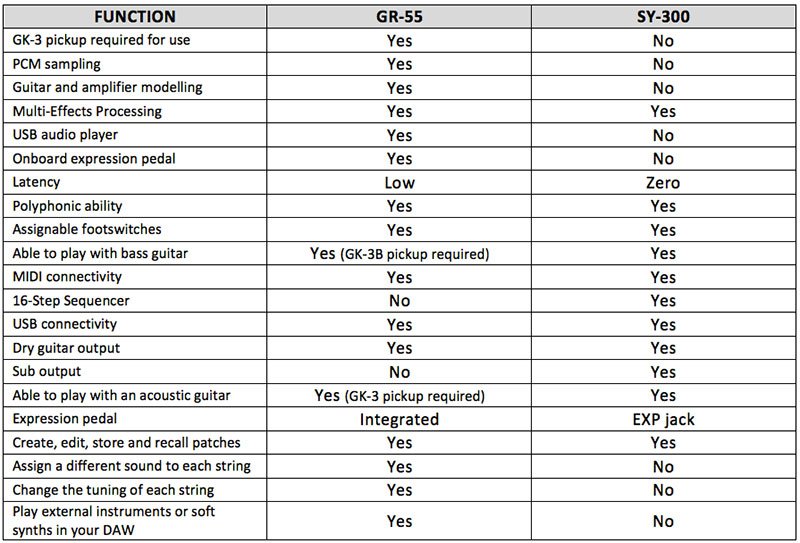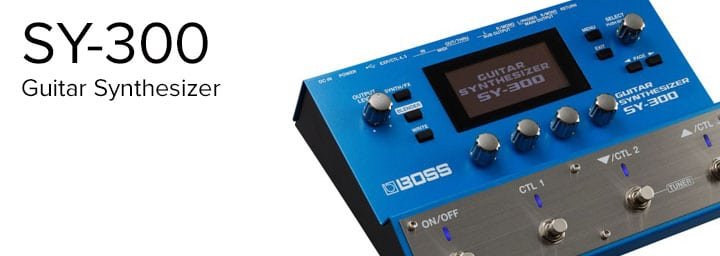For over 35 years, Roland guitar synthesizers have provided guitar and bass players with the means to coax astonishing sounds from their instruments. There’s something special about seeing a musician wielding a guitar which can unleash the sound of a full orchestra, a percussion ensemble, a sequenced trip-hop bass line, a piano concerto, or a fat 80s style synth. By giving musicians the means to transform their fretted instrument into any sound imaginable, Roland Guitar Synthesizers provide entirely new levels of creative expression.
Roland Corporation have been leading the guitar synthesis game ever since releasing the groundbreaking GR-500 in 1977. Today, there are two Roland units that bear the “Guitar Synthesizer” badge. They are the astounding Roland GR-55, and the amazingly innovative BOSS SY-300.
While both the GR-55 and the SY-300 have the “Guitar Synthesizer” name, in actual fact, they couldn’t be more different. The technology of the two devices are far removed from one another, their capabilities are vastly different, and they are designed to appeal to different types of guitar players.
Let’s take a look at the powerful Roland GR-55 and the cutting-edge BOSS SY-300 and see just how remarkably different they are from each other.
Contributed by Byron Struck for the Roland Australia Blog
Roland GR-55 – PCM Synthesizer with V-Guitar Power

Currently, Roland’s flagship guitar synthesizer is the incredible GR-55. A combination of different cutting edge technologies all merging into one unit, the GR-55 is essentially a Swiss Army knife for guitar.
Firstly, the GR-55 contains a powerful synthesizer engine that allows your guitar to sound like an accurate replica of dozens of instrument sounds. These include pianos, drums, woodwind, organs, synthesizers, and many more.
This in itself is pretty impressive, but it doesn’t stop there. The GR-55 also contains V-Guitar technology which not only allows your guitar to transform its tonality into a Strat®, Tele®, Les Paul®, Rickenbacker®, or many other fretted instruments with complete ease. Even more powerful than this, is the ability to perform alternate tunings (customisable on each string) without ever having to touch your guitar’s tuning keys. Want to go from a Strat® neck pickup tone in standard tuning to a sitar in drop C? No problem.
As if that wasn’t enough, the GR-55 has a full-blown, onboard, multi-effects processor that delivers a huge range of classic tube amplifier emulations and guitar effects.
For the advanced user, you can play soft synths in your DAW, and you can control drum machines, loopers and other instruments via MIDI. For practically anything you’d like to use it for, the GR-55 has you covered.
BOSS SY-300 – The Secret Weapon

More recently added to the Roland family of guitar synthesizers is BOSS’ SY-300. This fully polyphonic device is a very different kind of synthesizer to the GR-55, but no less impressive. Think of this unit as more like “the ultimate stompbox”.
Using oscillators (the core circuit of a traditional analog synthesizer) in combination with filters and multi-effects, the SY-300 is a rawer sounding guitar synthesizer than the GR-55. It melds with your guitar to provide classic synth tones, airy pads, throbbing electro lines and vast array of sounds and textures that no other stompbox could ever hope to achieve.
Same Same… But Different
So, both of these units are guitar synthesizers. But they both do different things. What? How does that work?
As mentioned earlier, both the GR-55 and SY-300 are different machines using different technology to appeal to different players. A critical technological difference between these two guitar synths is the method by which they are driven.
The bombastic SY-300 is just like a stompbox – it works on the signal sent by regular guitar pickups, meaning you can just plug in any electric guitar (or bass) and let loose with its earth-shattering synth tones.
To access the awe-inspiring capabilities of the GR-55 though, the simple output of a regular guitar pickup just won’t cut it. Instead, you’ll need to attach the Roland GK-3 Divided Pickup to your guitar. If you’re a bass player, you’ll require the GK-3B.
Regular guitar/bass pickups output the instrument signal as one complete audio waveform signal, no matter if you play one string or all six simultaneously! What the GK-3 pickups do, is to sense all six guitar strings separately, and deliver them as six separate output signals to the GR-55. Here, the unit can process each string completely independently. Check out this article from Roland USA for more information on how this works.
This is surely the technological tipping point between the GR-55 and SY-300. The SY-300 essentially allows you to “plug-in and play” to create monstrous sounds. However, in order for the GR-55 to perform its spellbinding show of PCM synthesis and altered tunings, then the ability to process each string independently is mandatory, therefore a GK pickup is an important requirement.
It should be becoming clear that the GR-55 and the SY-300 are two different beasts. Let’s dig a little deeper into the technologies at the heart of these incredible machines and explain why they’re so independent of each other.
Under The Hood
As mentioned, the GR-55’s ability to masquerade as different instruments lies in its use of PCM sampling. For the less synthesizer-savvy among you, PCM refers to Pulse Code Modulation. Here’s a great article on what different synth terms are and what they mean, if you’re interested.
PCM sampling is a way to record sounds from outside of the synthesizer. This includes other instruments (pianos, drums, strings, other synthesizers, etc.). It can then store the samples inside the guitar synthesizer and we can edit them with the guitar synth’s control parameters.
To play these sounds, we need the information from the GK pickup. The GK signal converts your guitar playing to data that the sampled sounds understand. As you’re now aware, the only possible way to play these sounds from a guitar is to use a GK pickup.
The SY-300 doesn’t use PCM samples. That means, all of its sounds are created using the technology within the box. It doesn’t use samples of external instruments so you can’t make your guitar sound like a piano, drum kit or other sampled instrument in the same way that the GR-55 can.
Instead, the SY-300 uses oscillators and filters to create unique tones. Oscillators create waveforms like saw waves, sine waves, triangle waves, etc., which modify your guitar signal (from your regular pickup) to produce synth style sounds. Filters are used to further shape the resulting wave, and from there you can add effects like reverb, slicer, distortion, etc.
The Future Remains The Same
One of the major misconceptions of recent times, is that since the SY-300 is able to create such impressive polyphonic tones using the signal from regular guitar pickups, then it must only be a matter of time before full PCM synthesis and altered tunings can be achieved in the same manner.
This is not the case at all. The technology of the GR-55 and the SY-300 is highly unlikely to merge at any point in the near future. GK pickups are still an absolute requirement in order to achieve the next level signal processing that the GR-55 is capable of.
Let’s recap with this video from Roland US, which outlines the two synthesizers:
Conclusion
As we have seen, both the Roland GR-55 and BOSS SY-300 are revolutionary instruments, both have the ability to extend boundless creativity to the user.
This reference table will give you more insight on both the GR-55 and the SY-300 that will help you decide which model is for you. Or maybe, you’d like both!

Check out the free patches from BOSS Tone Central for even more sounds!
Related Articles
GET THE MOST FROM YOUR BOSS SY-300 GUITAR PEDAL
GR-55 GUITAR SYNTHESIS
I HEART GUITAR ARTICLE: GUITAR SYNTHESIS
WHAT’S IT LIKE PLAYING GUITAR SYNTH?





